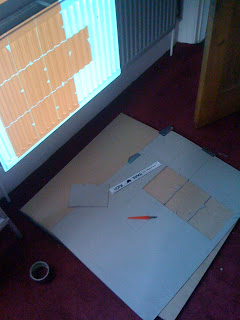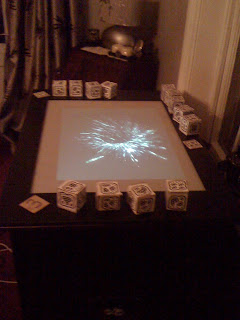Throughout this project people such as family members and university students have conducted user testing on a regular basis. The main areas to user test were the overall height requirements needed for the box, as I wanted it to be targeted towards a more adult aged user group. Tangibility was a huge factor to consider and work out how exactly I was going to go about making this a key aspect. I went for the Cube option on the table due to seeing the official Reactable Project work so well with it. They are easy to pick up and they also give me a much larger number of fiducials to work with due to them having 6 faces.
My project was kept on the quiet for the most case until it was built to a testing standard. So when the box was built (not painted) and some mock up cubes were made I took it into university and let a group of second year and third year students have a play.
I asked the students what they thought of the overall usability and they all seemed more than happy with it. They all agreed it took a few minutes to grasp what to do but that is the generally idea of the piece – to experiment with music with almost no instructions. So I feel I have hit my target head on and achieved exactly what I planned for. Other than that day at the university I haven’t really had anybody else text my product but I prefer the surprise to be honest.

4.Evaluation and Appraisal
Self-Appraisal:
I feel that throughout this project I have shown more determination than in any other project I have worked on over the past 3 years. Iv found that I have a passion for working with ReacTIVision and creating Table based tangible applications. It’s an area of interactive multimedia that I enjoy so I feel I must help to share it with others in all its glory. The Reactable was something I had just stumbled across 8 months ago whilst doing some online research. I have always been keen on the idea of touch implementation but to see a group of people controlling touch functions but with tangible objects and shapes really opened my eyes and mind to something totally new. Research really isn’t one of my strong points and I don’t usually enjoy it but throughout the development of this project I have enjoyed interacting with other people with the same interest in ReacTIVision as me and its great to see what other people are being inspired to create.
Comparing the initial design ideas I had at the start of the project with the finished product, id say that I have certainly stayed in the same target area but the project has naturally developed in order to meet my needs and keep up with my skill development. The Beat box I think has turned out better in the long run then I had originally planned. In my proposal I had stated that it was going to be usable by all age groups, which it still is but if I was to place it out onto the market id maybe aim it more towards older teenagers and adults who are really interested in music creation.
It has developed into more of a live performance piece than a gaming installation although you could re program it for that.
The Beat Box has defiantly been improved from its original designs and has overcome my original expectations. It has really helped me evolve my methods of working and opened my eyes into new technologies along with giving me a new range of skills in a numerous amount software programs.
I’m interested to see what the future brings for me as I plan to develop more table passed applications and products.
Improvements:
The thing that really did bring a struggle to my project development was funding. To really improve on the quality of the build would be to apply or have some kind of funding, as these projects don’t come cheap. If things go wrong such as camera modifications or functionality then you are looking at starting over. When a camera costs £25.00 having to replace one really takes its toll. I underestimated the overall cost of the project and I should have really made a rough estimate or calculation before hand, but in the end I managed to scrap what I had together and made use of as many resources I could get hold of. With funding the overall finish of the box and cubes would have been a lot better. I originally wanted to use Perspex for the cubes and a better quality wood may have been nice. As I said before I managed to make use of what I had and the overall look turned out much better than I thought.
The biggest improvement that I would make it to use a high quality LCD screen instead of Perspex and a camera and use a different form of marker tracking.
A ReacTIVision project is a lot to take on as a single developer so having a team where each member assigned to a role such as tracking, visuals, sound and table build would defiantly have its benefits.
Future Scope:
What does the future hold for ReacTIVision development and me? Well I’m personally going to keep going with my newly found interest and skill with multitouch applications. I have already moved onto new ideas and begun my initial planning to make these ideas reality.



























